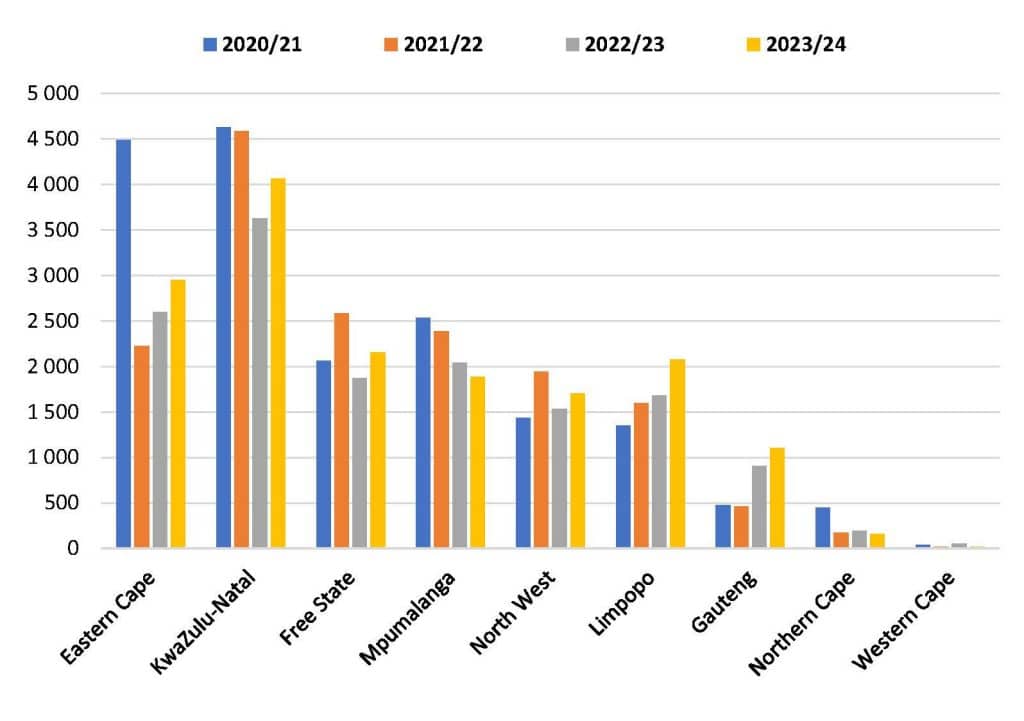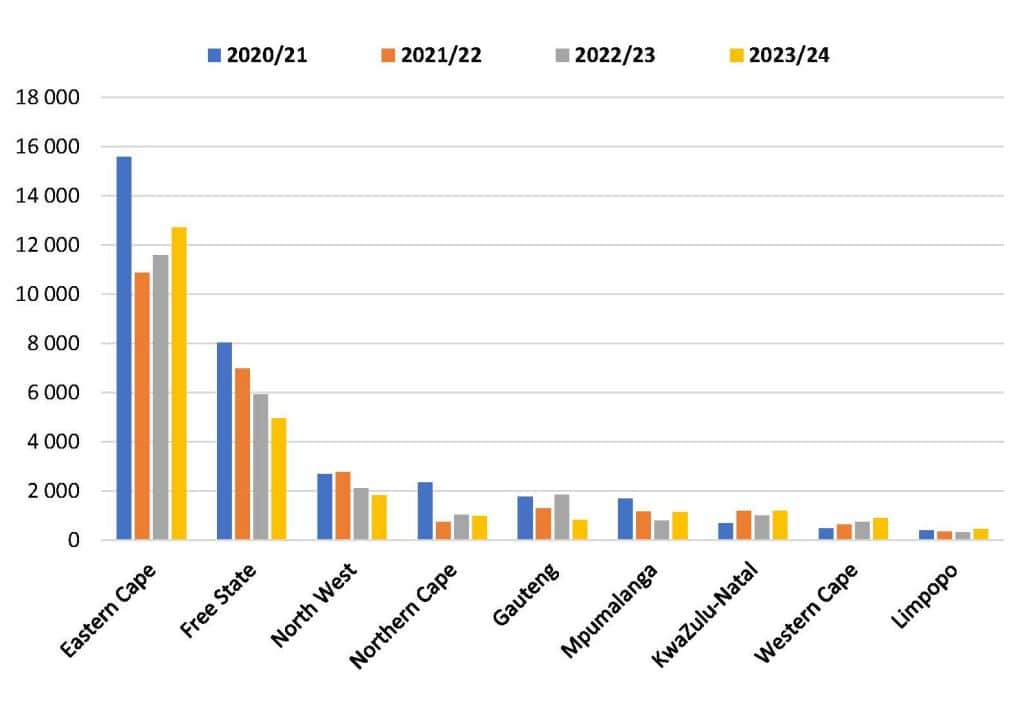Estimated reading time: 9 minutes
Understanding and comparing the theft of different livestock species across provinces is crucial for gaining insight into the dynamics of livestock theft and its impact on regional agricultural economies. By analysing the theft patterns of various species, such as cattle, sheep, and goats, across different provinces, we can identify trends, hotspots, and vulnerabilities within the livestock industry.
This information enables targeted interventions, resource allocation, and collaborative efforts to mitigate theft incidents, safeguard livestock assets, and promote the agricultural sector’s security and sustainability. In addition, comparing species-specific theft trends allows for a nuanced understanding of regional variations, contributing factors, and potential solutions tailored to the unique circumstances of each province and livestock species.
Ultimately, such comparisons facilitate evidence-based decision-making and effective strategies for combating livestock theft and protecting farmers’ livelihoods across South Africa.
Provincial theft comparison: Cattle

Figure 1 analyses the trends in cattle theft across provinces over the specified quarter year and reveals several key observations.
The magnitude of cattle theft
- KwaZulu-Natal consistently reports the highest number of stolen cattle, followed by the Eastern Cape.
- The Northern Cape and the Western Cape consistently report the lowest numbers of cattle theft.
Consistency
- Provinces such as Mpumalanga and the Free State show relatively stable trends, with minor fluctuations in the number of stolen cattle over the years.
- In contrast, provinces such as Gauteng and Limpopo exhibit more erratic patterns, with notable increases or decreases in theft incidents.
Trend direction
- Some provinces, such as Mpumalanga, demonstrate a consistent decrease in cattle theft over the specified period.
- Others, such as Gauteng and Limpopo, show an upward trend, indicating a worsening situation regarding cattle theft.
Regional variances
- Provinces in the eastern part of South Africa, such as KwaZulu-Natal, the Eastern Cape, and Limpopo, generally report higher incidences of cattle theft compared to provinces in the western part, such as the Northern Cape and the Western Cape.
- This regional variance suggests potential differences in factors contributing to cattle theft, such as geographic terrain, economic conditions, and law enforcement capabilities.
Provincial theft comparison: Sheep

Figure 2 contains an analysis of the trends in sheep theft across provinces over the specified quarter year, revealing several key observations.
The magnitude of sheep theft
- Eastern Cape consistently reports the highest number of stolen sheep, followed by the Free State.
- Provinces such as the Northern Cape, Gauteng, and Mpumalanga report relatively lower numbers than the Eastern Cape and Free State.
Consistency
- Free State consistently decreased sheep theft from 8 040 in 2020/21 to 4 957 in 2023/24, indicating successful efforts to reduce theft incidents.
- Other provinces, such as the Eastern Cape and North West, also show fluctuations, but there is no clear trend over the specified years.
Regional variances
- The Eastern Cape and Free State generally report higher incidences of sheep theft than provinces in the western parts, such as the Western Cape.
- This regional variance suggests potential differences in factors contributing to sheep theft, such as geographic terrain, economic conditions, and law enforcement capabilities.
Trend direction
- Some provinces, like Northern Cape and Limpopo, exhibit fluctuating patterns with no clear trend over the specified years.
- Others, such as Mpumalanga and KwaZulu-Natal, show variations but no significant overall trend in sheep theft.
Provincial theft comparison: Goats
Figure 3 contains an analysis of the trends in goat theft across provinces over the specified quarter year, and reveals several key observations.
Magnitude of goat theft
- KwaZulu-Natal consistently reports the highest number of stolen goats, followed by the Eastern Cape and North West.
- Western Cape consistently reports the lowest number of stolen goats among the provinces.
Consistency
- Provinces such as the Eastern Cape, North West, and Limpopo demonstrate relatively stable patterns in goat theft over the specified years, with minor fluctuations.
- Others, such as Mpumalanga and Gauteng, exhibit more variability in theft incidents, with fluctuating numbers yearly.
Regional variances
- Provinces in the eastern parts of South Africa, such as KwaZulu-Natal, the Eastern Cape, and Mpumalanga, generally report higher incidences of goat theft than provinces in the western part, such as the Western Cape.
- This regional variance suggests potential differences in factors contributing to goat theft, such as geographic terrain, economic conditions, and law enforcement capabilities.
Trend direction
- Some provinces, such as the Northern Cape and Free State, show a general decrease in goat theft over the specified years, indicating potential success in implementing anti-theft measures.
- Others, such as Gauteng, exhibit fluctuating patterns with no clear trend in theft incidents.
Findings comparison between the provinces
Comparing the trends in cattle, sheep, and goat theft across provinces reveals several vital similarities and differences.
The magnitude of theft
- Eastern Cape consistently reports the highest number of stolen livestock across all three species (cattle, sheep, and goats), followed by other provinces such as KwaZulu-Natal and Mpumalanga.
- Provinces in the Western part generally report lower numbers of stolen livestock than provinces in the eastern part of South Africa.
Consistency
- Provinces such as Mpumalanga and the Free State show relatively stable trends in theft incidents for all three species, with minor fluctuations over the years.
- Other provinces, such as Gauteng and Limpopo, exhibit more variability in theft incidents, with notable increases or decreases.
Trend direction
- Some provinces, such as Mpumalanga, demonstrate a consistent decrease in theft incidents for all three species over the specified period.
- Others, like Gauteng and Limpopo, show an upward trend or fluctuations, indicating challenges in addressing livestock theft.
Regional variances
- Provinces in the eastern part of South Africa generally report higher incidences of livestock theft across all three species compared to provinces in the western part.
- This regional variance suggests potential differences in contributing factors such as geographic terrain, economic conditions, and law enforcement capabilities.
Policy implications
- High-theft provinces may require targeted interventions and resource allocation to address security challenges and protect livestock assets.
- Lessons from provinces with declining theft rates, like Mpumalanga, could inform strategies for reducing cattle theft in other regions.
Recommendation on collaborative efforts
Considering collaborative efforts to address livestock theft across provinces, it is essential to highlight the function of the Interprovincial Livestock Theft Prevention Forum, particularly between Gauteng, Free State, North West, and Mpumalanga from 2013 to 2016. This forum focussed on coordinating efforts and resources to combat cross-border stock theft through dedicated units.
The forum was crucial in facilitating information sharing, joint operations, and co-operation among law enforcement agencies across provincial boundaries. By pooling resources and expertise, the forum aimed to enhance the effectiveness of livestock theft prevention measures and mitigate the challenges of criminal activities spanning multiple provinces.
Although the forum ceased its operations in 2016, its re-instatement is warranted to address ongoing security concerns and emerging trends in cattle theft. Given the persistent nature of cross-border stock theft and the evolving tactics employed by criminal networks, reviving the Interprovincial Livestock Theft Prevention Forum is imperative.
Reinstating the forum would enable participating provinces to re-establish collaborative mechanisms for intelligence sharing, joint patrols, and coordinated responses to livestock theft incidents. Moreover, it would provide a platform for stakeholders to identify and address systemic challenges, such as inadequate resources, legislative gaps, and logistical constraints, hindering practical livestock theft prevention efforts.
By revitalising this forum, provinces can strengthen their collective response to livestock theft, improve cross-border co-operation, and enhance the overall security of the red meat value chain. Furthermore, reinstating the forum demonstrates a commitment to proactive measures and intergovernmental collaboration in safeguarding livestock assets and promoting economic stability in affected regions.
Conclusion
Comparing livestock theft across provinces highlights the importance of comprehending theft patterns and trends to guide targeted responses and cooperative efforts. The results show that cattle, sheep, and goat theft have similar magnitudes, trends, and regional variances. Strategies to reduce theft elsewhere may be informed by lessons learned from regions with dropping theft rates, while targeted interventions may be necessary in high-theft areas.
Improving cross-border cooperation and fortifying responses to livestock theft require cooperative initiatives like the Interprovincial Livestock Theft Prevention Forum. These co-operative systems must be restored to protect South African farmers’ livelihoods and advance the security and sustainability of the red meat value chain.
Background note
This research aimed to explore livestock theft as a severe phenomenon in all provinces in South Africa. I intended to provide an impartial and objective analysis devoid of external influence, conflicts of interest, or vested interests.
Independence and impartiality
It is imperative to state that this report was entirely self-funded, and no external financial support, sponsorship, or grants were involved. I did not engage in any collaboration that might have compromised my ability to present an unbiased perspective.
Disclosure of conflicts of interest
In the interest of full transparency, I must disclose that I have no financial, professional, or personal affiliations that could sway the results or conclusions of this research. My views are solely based on a thorough investigation of the available literature and data and my expertise in the field.
Limitations
Like any endeavour, this report might have its limitations. Nevertheless, I have made every effort to minimise these limitations and ensure the validity and reliability of the presented findings. – Compiled by Willie Clack, senior lecturer in Criminal Justice at Unisa and a farmer in the North West. All statistics used are from official SAPS sources.
Copyright © 2024 Willie Clack. All rights reserved. No part of this publication may be reproduced, distributed, or transmitted in any form or by any means, including photocopying, recording, or other electronic or mechanical methods, without the prior written permission of the author, except for brief quotations embodied in critical reviews and certain other noncommercial uses permitted by copyright law. For permission requests, write to the author at the email address below.
Should you have any inquiries or require additional information, please do not hesitate to contact me at wclack@unisa.ac.za.







